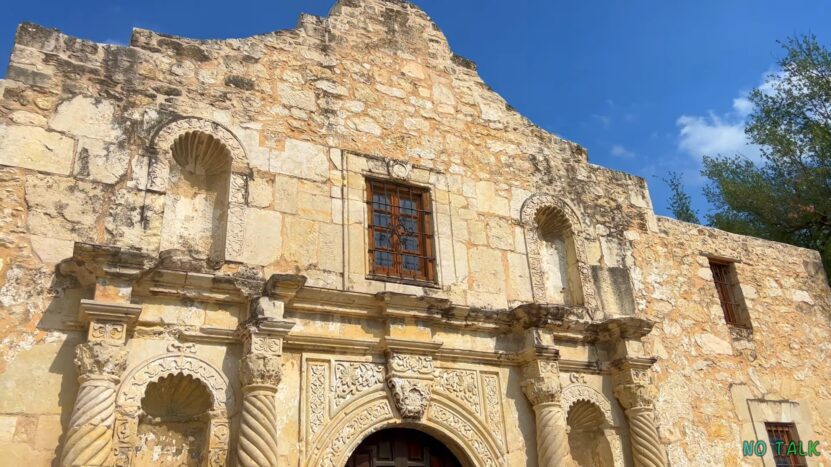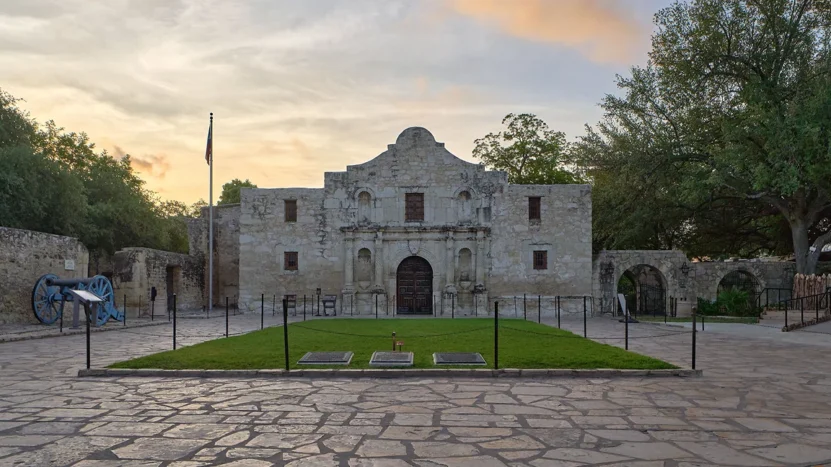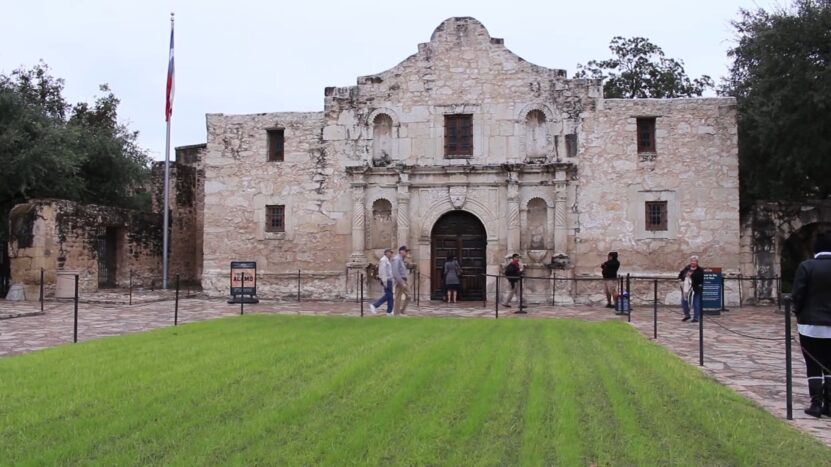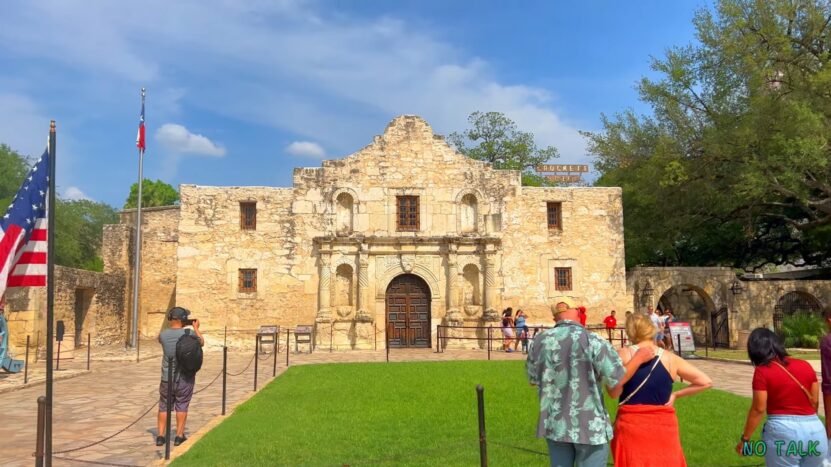A vacation in Texas just wouldn’t be complete without a trip to the Alamo San Antonio. After all, Texas’ history begins in San Antonio and the famous battle site of is not only a standing reminder of Texas’ past, but also a part of America’s defining history.
There are many fun things to do in San Antonio, as it is rich with history and full of culturally significant attractions, but the Alamo is perhaps its best known historical gem.
Here are seven most interesting facts about the Alamo San Antonio Mission that are sure to pique your interest:
A Historic Symbol of Texas

The Alamo, an iconic eighteenth-century church located in San Antonio, Texas, was originally constructed by Franciscan friars in 1718. Its purpose was to serve as a vital component of a larger mission aimed at converting the local indigenous populations to Christianity.
The Franciscan missionaries were instrumental in establishing a strong religious presence in the area, constructing the Alamo as part of the Mission San Antonio de Padua. The mission played a crucial role in the Spanish colonization of the region, as it facilitated the assimilation of the native populations into Spanish culture and religion.
Over the years, the Alamo has evolved into a symbol of Texan history and pride. This transformation is primarily due to the pivotal role the church played in the Battle of the Alamo in 1836, during the Texas Revolution. At the time, the Alamo was used as a makeshift garrison by a small group of Texan defenders, who fought against the Mexican forces led by General Antonio López de Santa Anna.
Popular Attraction near the Riverwalk San Antonio

Situated just a short distance from the bustling Riverwalk San Antonio, the Alamo is a tranquil oasis spread across more than four acres of land. As a major historical site, it attracts over two and a half million visitors annually.
The Alamo’s proximity to the lively Riverwalk San Antonio offers tourists an opportunity to explore both the rich history of Texas and the vibrant culture of the city in one visit. The Riverwalk, a famous urban waterway lined with picturesque walkways, shops, restaurants, and bars, is an ideal destination for those looking to experience the modern charms of San Antonio.
Visitors to the Alamo can immerse themselves in the fascinating story of the historic site while also taking advantage of its close location to the Riverwalk. The unique combination of history and entertainment makes the Alamo and the Riverwalk San Antonio two of the city’s must-see attractions for tourists and locals alike.
The Chapel at the Alamo: A Symbol of Courage and Sacrifice
The chapel at the Alamo mission, often referred to as the “Shrine of Texas Liberty,” stands as an enduring symbol of courage, sacrifice, and the struggle for American liberty. Its significance is rooted in the heroic actions of the Texan defenders during the Battle of the Alamo in 1836, a key event in the Texas Revolution.
During the battle, a small group of determined Texan fighters held their ground against the much larger Mexican forces led by General Antonio López de Santa Anna. Despite being heavily outnumbered and ultimately defeated, the bravery exhibited by the Alamo’s defenders inspired others to join the fight for Texas independence from Mexico. The rallying cry “Remember the Alamo!” became an emblem of resistance and a call to arms for those seeking freedom.
Today, the chapel at the Alamo mission serves as a poignant reminder of the sacrifices made by those who fought for liberty and the establishment of the Republic of Texas. Visitors to the Alamo can pay their respects and reflect on the enduring values of courage and determination that the chapel continues to represent.
The Battle of the Alamo: A Tale of Courage and Defiance
The Battle of the Alamo took place in 1836, during the Texas Revolution, when a small group of approximately two hundred Texan defenders valiantly resisted General Santa Anna’s much larger Mexican army. Led by iconic figures David Crockett, James Bowie, and William B. Travis, this tenacious band of Texans fought for thirteen days before ultimately succumbing to the overwhelming Mexican forces.
The defenders of the Alamo, despite being vastly outnumbered, demonstrated remarkable courage and determination in the face of seemingly insurmountable odds. Their fierce resistance and ultimate sacrifice galvanized the Texan cause for independence from Mexico and inspired countless others to join the fight.
In the aftermath of the battle, the rallying cry “Remember the Alamo!” emerged as a powerful symbol of the struggle for freedom and the resilience of the Texan spirit. Today, the Alamo remains an iconic symbol of the sacrifices made for liberty and the enduring determination of those who fought for the establishment of the Republic of Texas.
Sam Houston’s Victory at San Jacinto: A Tribute to the Alamo Defenders
A few weeks after the Battle of the Alamo, Texan General Sam Houston led his forces to a decisive victory against General Santa Anna at the Battle of San Jacinto. As the Texans fought for their independence, they were fueled by the memory of the brave defenders of the Alamo, and a battle-cry that would soon become famous around the world was born: “Remember the Alamo!”
The Battle of San Jacinto, which took place on April 21, 1836, was a turning point in the Texas Revolution. Houston’s forces, inspired by the courage and sacrifice of the Alamo’s defenders, charged at the Mexican army, catching them by surprise. The fierce engagement lasted only 18 minutes, but it resulted in a stunning victory for the Texans and ultimately led to the capture of General Santa Anna.
The battle-cry “Remember the Alamo!” served as both a tribute to the fallen heroes of the Alamo and a rallying call for Texans to fight for their independence. The phrase would go on to resonate with people around the globe, symbolizing the spirit of resistance, determination, and the struggle for liberty.
The Alamo’s Preservation: A Testament to Texas History

The Alamo in San Antonio suffered significant damage during the historic battle that took place in 1836. Over time, various efforts were made to restore and preserve the iconic site. In 1905, the state of Texas purchased the Alamo, recognizing its importance as a symbol of Texan history and pride.
Subsequently, the state entrusted the care and maintenance of the Alamo to the Daughters of the Republic of Texas, a dedicated group committed to preserving Texas’s unique heritage. The organization has diligently worked to maintain the compound, ensuring that the Alamo remains a powerful symbol of the sacrifices made by the brave defenders during the Texas Revolution.
Today, the Alamo stands as a testament to the enduring spirit of those who fought for liberty and the establishment of the Republic of Texas. Thanks to the efforts of the Daughters of the Republic of Texas, the Alamo continues to serve as a poignant reminder of the courage, sacrifice, and determination that shaped the history of the Lone Star State.
A Modest Monument with a Powerful Legacy
The Alamo in San Antonio is a relatively modest structure, measuring approximately sixty feet wide and thirty feet tall. Despite its small size, this limestone building holds great significance in Texas history and stands as a powerful symbol of courage, sacrifice, and the fight for liberty.
The unassuming appearance of the Alamo belies the immense impact it has had on the collective memory and identity of Texans. The site, which was once a battleground for a small group of determined defenders during the Texas Revolution, now serves as a poignant reminder of their bravery and unwavering spirit.
Today, visitors to the Alamo San Antonio can appreciate the historic site’s modest dimensions while reflecting on the larger-than-life legacy that it represents. The Alamo’s enduring significance in Texas history serves as a testament to the importance of remembering and honoring the sacrifices made in the pursuit of freedom and independence.
A visit to San Antonio is incomplete without immersing yourself in its rich history and cultural significance. To truly encounter the ghosts of Texas’ past and appreciate the city’s historical legacy, taking one of the many San Antonio tours through the Alamo is a must.
The Alamo, a symbol of courage, sacrifice, and the struggle for liberty, offers visitors the opportunity to step back in time and experience a pivotal moment in Texas history. As you explore the iconic site on a guided tour, you’ll gain a deeper understanding of the events that unfolded during the Texas Revolution and the bravery of the Alamo’s defenders.
In addition to the Alamo, San Antonio boasts a wealth of other historical and cultural attractions, such as the vibrant Riverwalk, the Spanish colonial missions, and various museums, galleries, and markets. By participating in a guided tour, you’ll not only learn about the city’s storied past but also discover the rich tapestry of culture and tradition that continues to shape San Antonio today.

If you’re fascinated by ancient architecture, be sure to check out these intriguing facts about the Abu Simbel Temple.
FAQ
What is the historical significance of the Alamo?
The Alamo is a historic site in San Antonio, Texas, that played a crucial role in the Texas Revolution. It was the location of the Battle of the Alamo in 1836, where a small group of Texan defenders fought against the much larger Mexican army led by General Antonio López de Santa Anna. Despite their defeat, the defenders’ bravery inspired others to join the fight for Texas independence, leading to the famous battle cry, “Remember the Alamo!”
Where is it located?
The Alamo is located in downtown San Antonio, Texas, only a few blocks away from the popular Riverwalk San Antonio. Its central location makes it easily accessible for visitors who want to explore both the historic site and the vibrant urban attractions nearby.
What can I expect to see during a visit to the Alamo?
During a visit to the Alamo, you’ll be able to explore the iconic chapel, known as the “Shrine of Texas Liberty,” as well as various exhibits showcasing artifacts and displays related to the Texas Revolution. You can also explore the tranquil grounds surrounding the Alamo, which cover more than four acres and include several monuments and plaques commemorating the events that took place there.
Are guided tours available at the Alamo?
Yes, guided tours are available at the Alamo, offering visitors an in-depth exploration of the site’s history, architecture, and the events that unfolded during the Texas Revolution. These tours are led by knowledgeable guides who can provide fascinating insights and answer any questions you might have about the Alamo and its significance in Texas history.
How much does it cost to visit?
Admission to the Alamo is free for visitors. However, guided tours and special programs may have additional fees. It is recommended to check the official Alamo website for the most up-to-date information on tour pricing and availability.
When is the best time to visit ?
The Alamo is open year-round, but the best time to visit depends on your personal preferences. San Antonio experiences hot summers and mild winters, so if you prefer cooler weather, you may want to visit during the fall or winter months. Additionally, visiting during weekdays or outside of peak tourist seasons can help you avoid crowds and enjoy a more leisurely experience.
Conclusion
The Alamo in San Antonio stands as a powerful symbol of courage, sacrifice, and the pursuit of liberty. Its historical significance and rich cultural context make it an essential destination for anyone visiting the city. Exploring the Alamo and its surroundings, along with other attractions in San Antonio, offers a unique and memorable experience that connects visitors to the enduring spirit of Texas history.

